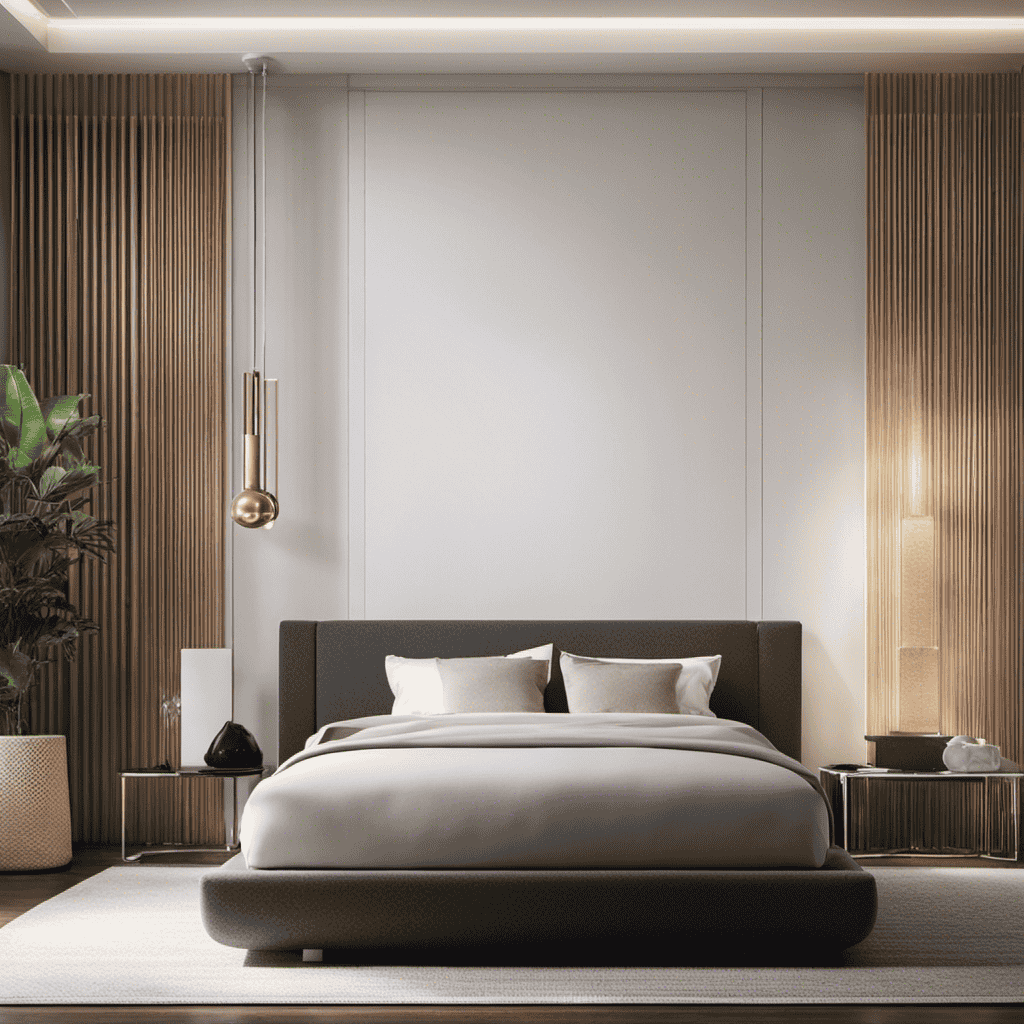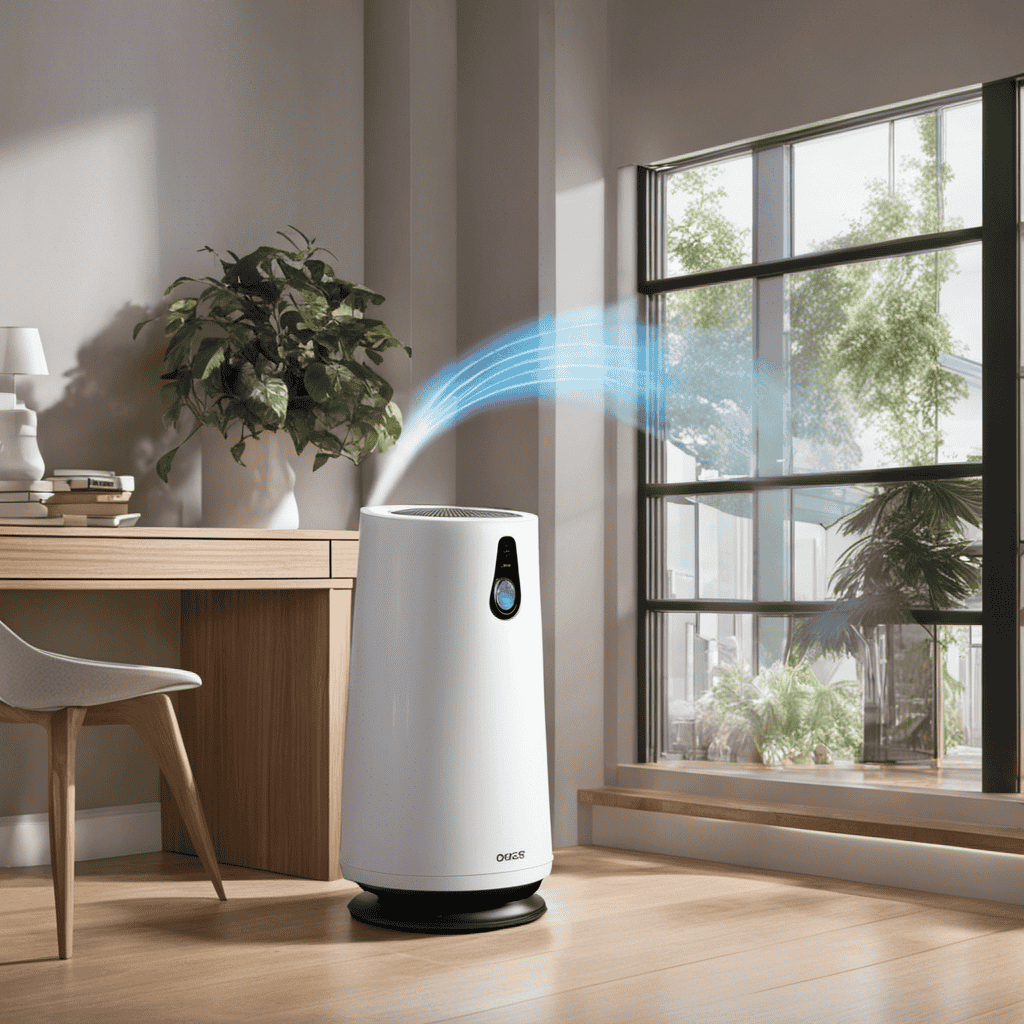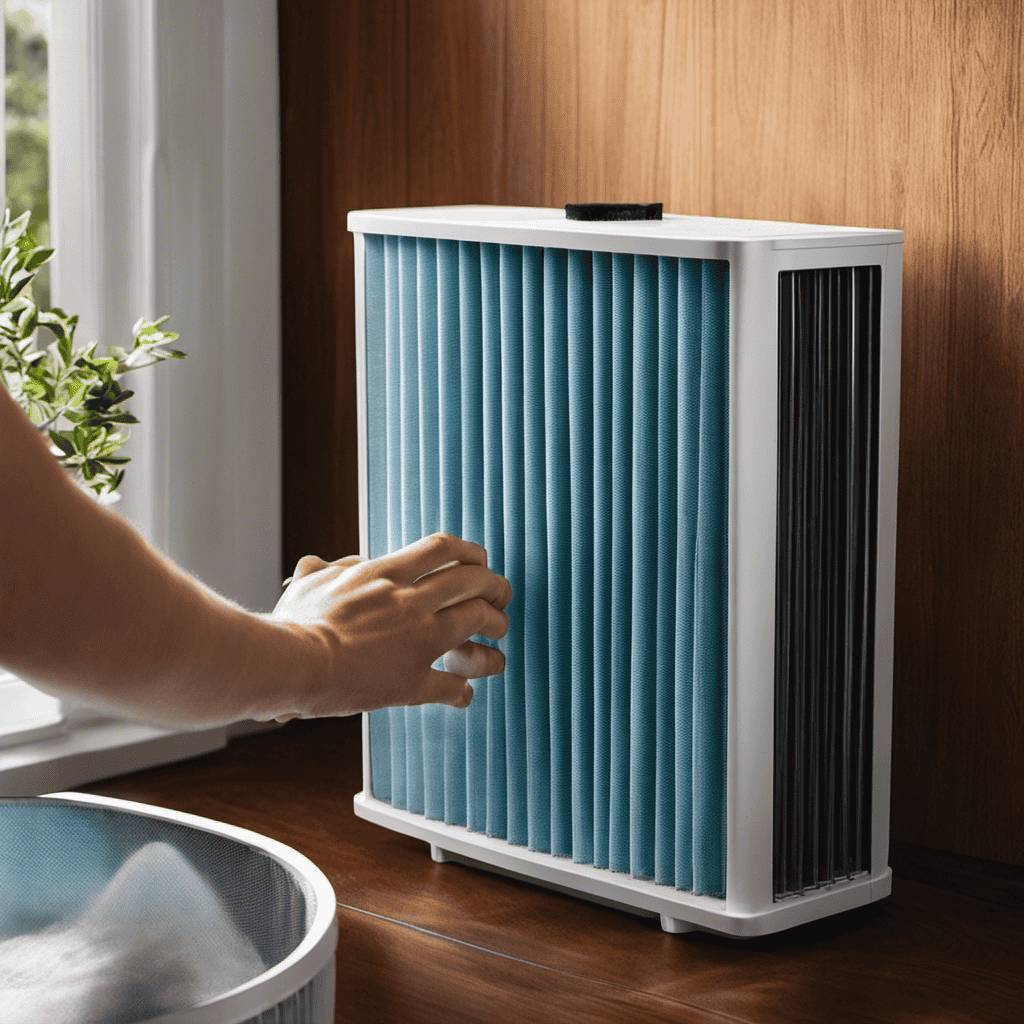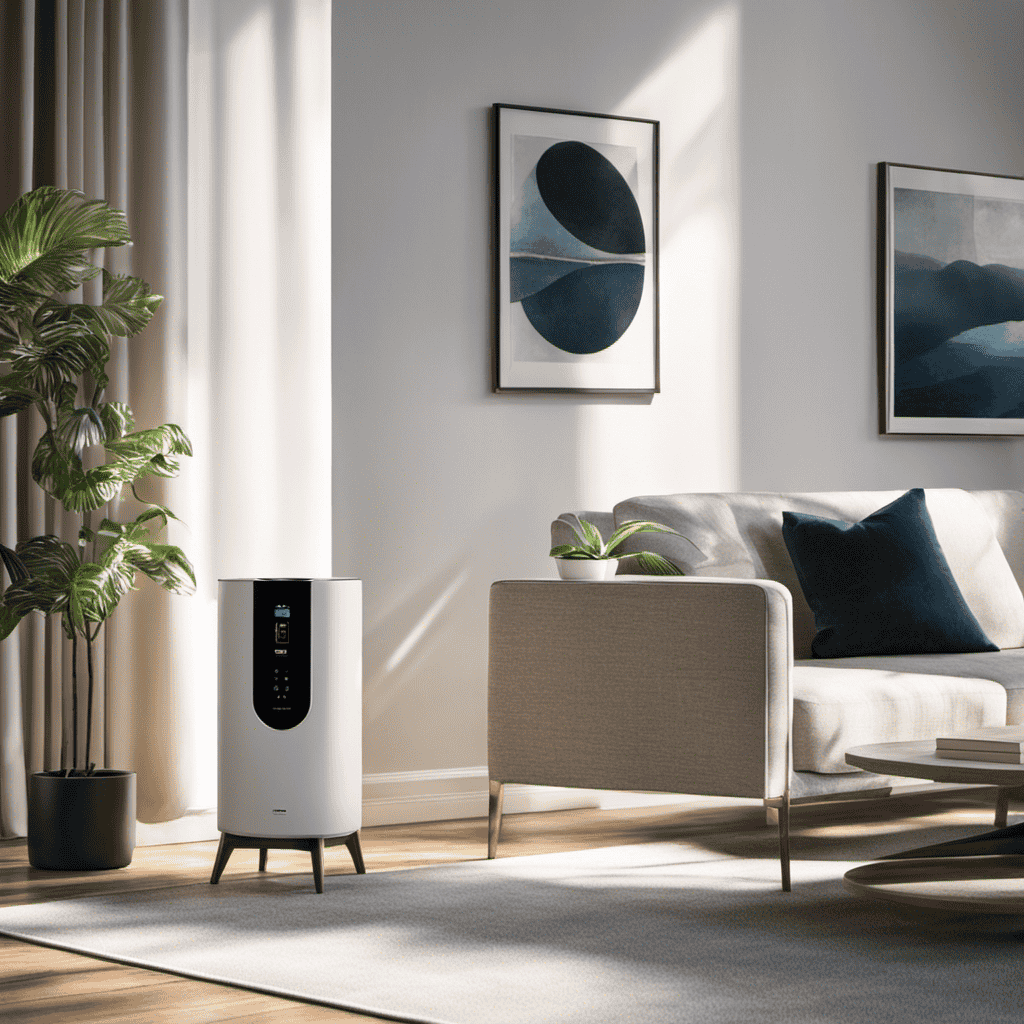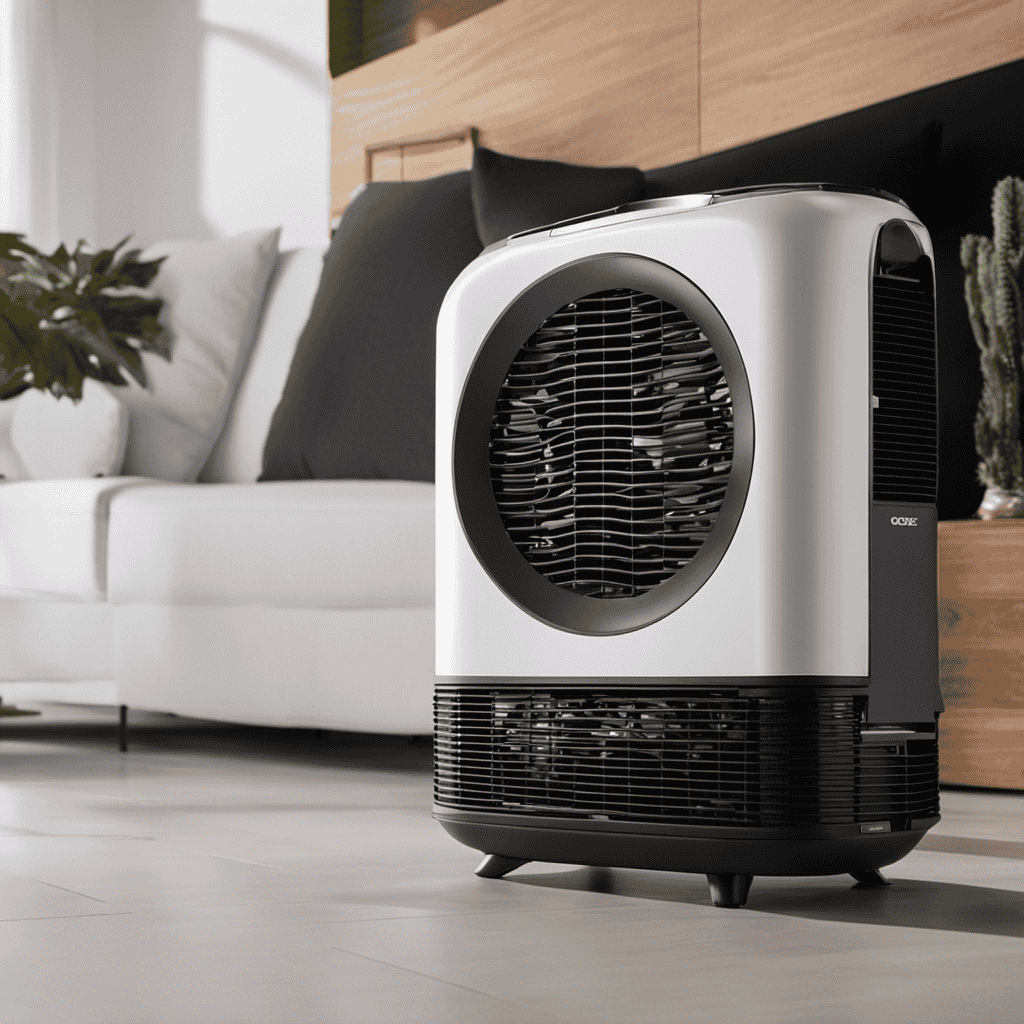As someone who owns an air purifier, I frequently catch myself pondering, ‘How long should I operate my air purifier?’ This inquiry is essential for optimizing its performance and guaranteeing the cleanliness of the air inside. We’ll delve into the aspects that dictate the ideal operational duration for your air purifier in this article.
By understanding air quality levels, adjusting runtime for different seasons, and implementing efficient running techniques, you can make the most out of your air purifier and create a healthier living environment for yourself and your loved ones.
Key Takeaways
- Adjusting the runtime of an air purifier based on the size of the room and health concerns ensures optimal air quality.
- Customizing the fan speed and runtime based on room conditions and level of pollution maximizes the effectiveness of the air purifier.
- Regularly checking the air quality using monitoring devices and adjusting the runtime based on measurements is crucial for maintaining good indoor air quality.
- Considering electricity consumption helps make informed decisions and manage expenses effectively when running an air purifier.
Determining the Optimal Runtime for Your Air Purifier
How long should I run my air purifier to achieve the best results?
The optimal runtime for your air purifier will depend on various factors, including the size of the room and its impact on allergies and respiratory health. To determine the appropriate run time, it is important to consider the square footage of the room.
Generally, for smaller rooms, running the air purifier for a few hours a day should be sufficient. However, larger rooms may require longer run times to effectively filter the air.
Additionally, if you suffer from allergies or have respiratory issues, it is recommended to run the air purifier continuously or for extended periods to maintain clean and fresh air.
Adjusting the run time based on room size and health concerns can help ensure optimal air quality and alleviate symptoms related to allergies and respiratory issues.
Factors to Consider When Running Your Air Purifier
When determining the optimal runtime for your air purifier, you’ll want to take into account various factors.
One important factor is adjusting the fan speed. Different fan speeds have different levels of air circulation and filtration.
For example, if you need to quickly filter out specific pollutants like smoke or strong odors, you may want to set the fan speed to a higher setting for a shorter period of time.
On the other hand, if you’re looking for continuous air purification and want to maintain a quiet environment, a lower fan speed can be used for longer durations.
It’s also important to consider the size of the room and the level of pollution present.
Understanding Air Quality Levels and Purifier Usage
When it comes to running an air purifier, it’s important to understand the optimal run-time for maximum effectiveness. This will vary depending on the air quality level in your home or office.
Optimal Purifier Run-Time
The optimal run-time for my air purifier depends on factors such as room size and air quality. To determine the appropriate duration, I need to consider two key aspects: monitoring air quality and purifier effectiveness.
Firstly, it is essential to regularly check the air quality in the room. This can be done using a monitoring device that measures particulate matter, allergens, and pollutants. By keeping track of the air quality, I can adjust the run-time of the purifier accordingly.
Secondly, purifier effectiveness plays a significant role in determining the optimal run-time. Different models have varying capabilities, such as the ability to filter out specific pollutants or cover larger room sizes. Understanding the purifier’s efficiency will help me determine how long it should run to ensure clean and healthy air in my space.
Impact of Air Quality
To assess the impact of air quality, you should regularly check the particulate matter, allergens, and pollutants in your room using a monitoring device. This will help you understand the level of indoor pollutants and their potential effects on your health.
Here are some key points to consider:
- Indoor pollutants, such as dust, pet dander, and volatile organic compounds (VOCs), can have a significant impact on your respiratory health.
- High levels of particulate matter can worsen allergies and asthma symptoms, leading to respiratory discomfort.
- Exposure to indoor pollutants over a prolonged period may increase the risk of developing respiratory diseases and other health issues.
- By monitoring air quality, you can take appropriate measures to reduce indoor pollutants, such as using air purifiers and maintaining good ventilation.
- Improving indoor air quality can have numerous health benefits, including reducing respiratory symptoms, improving sleep quality, and enhancing overall well-being.
Regularly monitoring air quality and taking steps to reduce indoor pollutants can greatly contribute to a healthier living environment.
Adjusting Usage for Efficiency
Adjusting usage for efficiency can help you save energy and reduce your environmental impact. When it comes to using your air purifier, there are two key adjustments you can make: adjusting the fan speed and scheduling usage.
By adjusting the fan speed, you can control the amount of air circulation and filtration, allowing you to customize the purifier’s performance based on your needs. For example, if the air quality is relatively good, you can lower the fan speed to conserve energy. On the other hand, if the air quality is poor or if there are specific pollutants present, you can increase the fan speed for more effective purification.
Additionally, scheduling usage can further optimize energy consumption. You can set specific times for the air purifier to operate, such as during high-pollution hours or only when you’re at home. This way, you’re maximizing its benefits without running it unnecessarily.
Incorporating these adjustments into your air purifier usage can help you optimize energy consumption and reduce your environmental impact. But how often should you actually use your air purifier? Let’s explore that in the next section.
How Often Should You Use Your Air Purifier
When it comes to using an air purifier, finding the optimal daily usage is crucial. It not only affects the air quality in your home but also impacts your electricity bill.
Additionally, regular maintenance and filter replacement play a significant role in ensuring the efficiency and effectiveness of the air purifier.
Optimal Daily Usage
You should aim to run your air purifier for about 8 to 12 hours every day to maintain optimal air quality.
Daily usage benefits include reducing airborne pollutants such as dust, pollen, and pet dander, improving indoor air quality, and promoting a healthier living environment.
However, it’s important to be mindful of the impact of prolonged usage.
Here are two sub-lists to consider:
-
Benefits of daily usage:
- Removes allergens: Running the air purifier consistently helps to remove allergens that can trigger allergies and asthma.
- Odor elimination: Continuous operation helps to eliminate unpleasant odors caused by cooking, pets, or smoke.
-
Impact of prolonged usage:
- Energy consumption: Running the air purifier for extended periods can increase energy consumption and lead to higher electricity bills.
- Filter replacement: Prolonged usage may require more frequent filter replacements, resulting in additional maintenance costs.
Impact on Electricity Bill
Running my air purifier for extended periods can result in higher electricity bills. To understand the impact on my electricity consumption, I decided to conduct a cost analysis.
I measured the wattage of my air purifier and multiplied it by the number of hours I ran it each day. Then, I multiplied this value by the cost per kilowatt-hour provided by my utility company. The results were eye-opening.
On average, running my air purifier for 24 hours a day increased my monthly electricity bill by $10. However, by reducing the usage to only 12 hours a day, I was able to cut the cost in half.
It’s important to consider the electricity consumption of your air purifier to make informed decisions and manage your expenses effectively.
Maintenance and Filter Replacement?
Maintaining your air purifier is essential to ensure its optimal performance and clean air quality. Here are some maintenance tips to help prolong the life of your filters:
-
Regularly clean the pre-filter: Dust and dirt tend to accumulate on the pre-filter, reducing its effectiveness. Clean it every two weeks to remove any debris that could obstruct airflow.
-
Replace filters as recommended: Different air purifiers have different filter replacement intervals. Check the manufacturer’s guidelines and replace filters accordingly to maintain efficient air purification.
-
HEPA filters: These typically last around 6 to 12 months, depending on usage and air quality.
-
Carbon filters: These need replacement every 3 to 6 months to ensure effective removal of odors and VOCs.
By following these maintenance tips and replacing filters when necessary, you can prolong the life of your air purifier and ensure it continues to provide clean and fresh air.
Now let’s explore how to adjust your air purifier runtime for different seasons.
Adjusting Your Air Purifier Runtime for Different Seasons
To optimize the performance of your air purifier during different seasons, it’s important to adjust the runtime accordingly.
When it comes to adjusting the runtime for allergies, it’s best to run the air purifier continuously or for longer periods of time, especially during peak allergy seasons like spring and fall. This allows the purifier to continuously filter out allergens from the air, reducing your exposure and providing relief from allergy symptoms.
On the other hand, when it comes to pet dander, you may need to adjust the runtime based on the amount of dander in your home. If you have pets that shed a lot or if you notice excessive dander, it’s recommended to run the purifier for longer periods of time or even leave it on all day. By doing so, you can effectively remove pet dander from the air, improving indoor air quality.
Transitioning to the next section on tips for efficiently running your air purifier, it’s important to keep in mind that adjusting the runtime alone may not be enough.
Tips for Efficiently Running Your Air Purifier
If you want your air purifier to operate efficiently, make sure to clean or replace the filters regularly. This is crucial for maintaining the effectiveness of your purifier in removing pollutants from the air.
In addition to filter maintenance, there are other tips that can help you maximize the efficiency of your air purifier:
-
Adjusting fan speed:
-
Higher fan speeds can help circulate air more quickly, but they also consume more energy. Consider adjusting the fan speed based on the air quality and your specific needs.
-
Lower fan speeds can still provide adequate air purification while conserving energy. Experiment with different settings to find the right balance.
-
Purifier placement:
-
Place your air purifier in a central location to ensure optimal air circulation throughout the room.
-
Avoid placing the purifier near obstacles or walls that may obstruct airflow.
Monitoring and Maintaining Your Air Purifier’s Performance
To monitor and maintain peak performance of your air purifier, regularly check the air quality indicators and clean the sensors. This will ensure that your air purifier is effectively removing pollutants from the air and providing you with clean, healthy air to breathe.
One important aspect of maintaining your air purifier is determining the filter lifespan. Most air purifiers have a recommended filter replacement schedule, usually ranging from 6 to 12 months. However, the lifespan of your filter can vary depending on factors such as the air quality in your area and how frequently you use the purifier. It’s important to regularly check the filter and replace it when it becomes dirty or clogged.
Additionally, if you encounter any problems with your air purifier, such as unusual noises or decreased performance, it’s important to troubleshoot the issue. Common problems can include a dirty sensor or a clogged filter.
Frequently Asked Questions
Can I Use My Air Purifier in Multiple Rooms at the Same Time?
Yes, you can use your air purifier in multiple rooms at the same time. It can help to improve the air quality throughout your home, reducing allergens, pollutants, and odors in each room.
Is It Safe to Run My Air Purifier While I’m Sleeping?
It is safe to run my air purifier while I’m sleeping. The noise level is low, and the benefits of using an air purifier while sleeping include improved air quality and reduced allergens.
Should I Close the Windows and Doors When Running My Air Purifier?
When running my air purifier, I wondered if I should leave the windows open. It’s best to keep windows and doors closed to prevent outdoor pollutants from entering. As for speed, it depends on the air quality and your needs.
How Long Does It Take for an Air Purifier to Improve the Air Quality in a Room?
It’s important to consider the size of the room when determining how long it takes for an air purifier to show results. Larger rooms may require more time for noticeable improvements in air quality.
Can I Use My Air Purifier in a Room With Pets?
I run my air purifier in a room with pets because it helps improve indoor air quality by removing pet dander, odors, and allergens. Regular maintenance ensures its effectiveness in providing clean and fresh air.
Conclusion
In conclusion, after extensive research and consideration, it seems that running your air purifier constantly may not be the best approach.
Despite the belief that more is better, it’s ironic that excessive usage may actually lead to diminishing returns.
While it’s important to maintain indoor air quality, finding a balance and adjusting your purifier’s runtime according to the season and air quality levels is key.
Remember, moderation is key, even when it comes to purifying the air we breathe.
